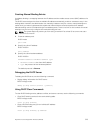
• Source Address Validation
Option 82
RFC 3046 (the relay agent information option, or Option 82) is used for class-based IP address
assignment.
The code for the relay agent information option is 82, and is comprised of two sub-options, circuit ID and
remote ID.
Circuit ID This is the interface on which the client-originated message is received.
Remote ID This identifies the host from which the message is received. The value of this sub-
option is the MAC address of the relay agent that adds Option 82.
The DHCP relay agent inserts Option 82 before forwarding DHCP packets to the server. The server can
use this information to:
• track the number of address requests per relay agent. Restricting the number of addresses available
per relay agent can harden a server against address exhaustion attacks.
• associate client MAC addresses with a relay agent to prevent offering an IP address to a client
spoofing the same MAC address on a different relay agent.
• assign IP addresses according to the relay agent. This prevents generating DHCP offers in response to
requests from an unauthorized relay agent.
The server echoes the option back to the relay agent in its response, and the relay agent can use the
information in the option to forward a reply out the interface on which the request was received rather
than flooding it on the entire VLAN.
The relay agent strips Option 82 from DHCP responses before forwarding them to the client.
To insert Option 82 into DHCP packets, follow this step.
• Insert Option 82 into DHCP packets.
CONFIGURATION mode
ip dhcp relay information-option [trust-downstream]
For routers between the relay agent and the DHCP server, enter the trust-downstream option.
• Manually reset the remote ID for Option 82.
CONFIGURATION mode
ip dhcp relay information-option remote-id
DHCP Snooping
DHCP snooping protects networks from spoofing. In the context of DHCP snooping, ports are either
trusted or not trusted.
By default, all ports are not trusted. Trusted ports are ports through which attackers cannot connect.
Manually configure ports connected to legitimate servers and relay agents as trusted.
When you enable DHCP snooping, the relay agent builds a binding table — using DHCPACK messages —
containing the client MAC address, IP addresses, IP address lease time, port, VLAN ID, and binding type.
Every time the relay agent receives a DHCPACK on a trusted port, it adds an entry to the table.
The relay agent checks all subsequent DHCP client-originated IP traffic (DHCPRELEASE, DHCPNACK, and
DHCPDECLINE) against the binding table to ensure that the MAC-IP address pair is legitimate and that the
330
Dynamic Host Configuration Protocol (DHCP)


















